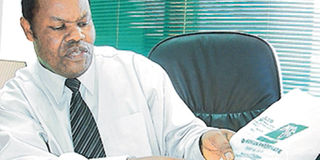To better our farming, we need policy on soil and fertiliser use

Eustace Muriuki, the committee co-chairman of the Kenya Fertiliser Platform (KeFERT). He notes that a soil policy will address soil-related issues in totality, from managing soil acidity to selling region and crop-specific fertilisers. PHOTO | ANITA CHEPKOECH | NMG
What you need to know:
- In the new system, farmers’ details including their acreage will be captured in the loaded voucher, which they will use to access the commodity from dealers of their own choice.
- We shall also call for countrywide soil tests and use the results to decide which types of fertilisers are best for each region to increase production and productivity.
- The average maize yield in the country does not go beyond two metric tonnes per hectare, that’s 10 bags of 90kg per acre despite the heavy fertiliser use.
- e are also encouraging farmers to invest in it. It costs Sh2,000 to test soil and retesting is done after about five years.
Over the years, the fertiliser industry has been dogged by various challenges, which include supply of fake produce. To curb the vices, stakeholders in the sector recently formed the Kenya Fertiliser Platform (KeFERT). Eustace Muriuki, the committee’s co-chairman, spoke to Anita Chepkoech on how they will use the platform to transform the sector
What is KeFERT and why should farmers care about it?
This is a public-private platform chaired by the Ministry of Agriculture and the Fertiliser Association of Kenya and comprises key stakeholders in the sector.
Its main aim is to identify and address policy issues and constraints facing the sector. We launched the association last month and we hope through it, we will iron out the many challenges in the sector.
You are leading a campaign to overhaul the government fertiliser subsidy programme. Why, yet many smallholder farmers rely on the subsidy?
Our aim is to improve the programme by making it more beneficial to farmers. Currently, unscrupulous businessmen take advantage of the subsidy to purchase fertiliser, repackage and sell it to farmers at exorbitant prices.
The smart system we are advocating for involves use of electronic vouchers to ensure that people who receive input are only those who have been vetted and are deserving.
In the new system, farmers’ details including their acreage will be captured in the loaded voucher, which they will use to access the commodity from dealers of their own choice.
One of the things the association is working on is soil policy. What is it about?
A soil policy will address soil-related issues in totality, from managing soil acidity to selling region and crop-specific fertilisers.
We will begin by looking at the standards of the fertiliser we sell vis-à-vis the nature of our soil and crops. If there is any contention, we will bring the issues to the platform to be deliberated between the government and the private sector.
We shall also call for countrywide soil tests and use the results to decide which types of fertilisers are best for each region to increase production and productivity.
We will work with the counties to come up with soil fertility maps and every county will have its own map to guide farmers on the condition of their soil in every part, and know what type of fertiliser is suitable to apply on what crop.
Also, manufactured and imported fertiliser will have to factor in the problems of the Kenyan soil.
Most farmers are not getting much from the soil despite increased fertiliser use. Does that concern you?
These are consequences of inappropriate application of fertilisers. In some places, you find a farmer whose farm has acidic soil continuing to apply acidic fertiliser thus destabilising the pH.
The ideal soil pH ranges from 5.5 to 6.5, but when you apply, say phosphorous on soil with high acidity (pH of below 5), then phosphorous is tied up by aluminium and iron to form a complex compound like Aluminium phosphate, held so tightly that the plant is unable to absorb the phosphorous.
So the liming is important as a way of correcting the acidity. That is why soil testing is important. The average maize yield in the country does not go beyond two metric tonnes per hectare, that’s 10 bags of 90kg per acre despite the heavy fertiliser use.
But if farmers correct the soil, they will get up to 30 bags of maize per acre, using the same amount of fertiliser.
Do farmers understand these dynamics?
Some farmers know and others need to be trained, which is why we are pushing for a soil policy so that the government does the testing at subsidised rates.
We are also encouraging farmers to invest in it. It costs Sh2,000 to test soil and retesting is done after about five years.
Can the government cede the management of subsidy fertiliser as the private sector wants?
We are in talks and I can say we are happy as private sector because running the industry should not be a one-man show. Going forward it will be a concerted effort, where KeFERT will be the voice of the industry.





